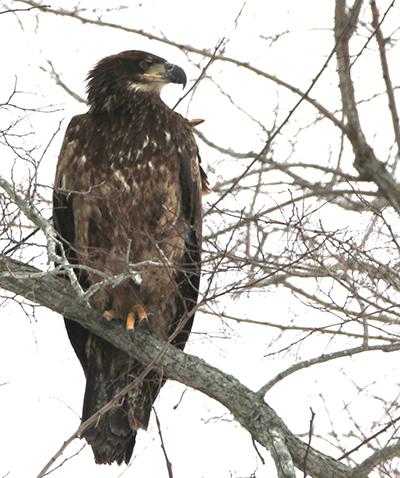Nature Notes: The Eagles Have Landed

After achieving a historic low in the 1960s, owing to wide use of DDT and other pesticides, the Long Island osprey populations have bounced back and are still rising. But the increasing number of cormorants and seals in our waters since the 1990s is nettling their comeback, and now there is a third competitor on the scene to contend with — one most of us are happy for: our national bird.
Yes, the bald eagle is making a comeback, having disappeared as a breeder in the area in 1936. Seventy years later it looks like the species is back to stay. The past winter witnessed a record number of them, and the chicks in the three local nests have almost reached fledgling stage.
Just about every layperson I talk to has seen one of these magnificent birds fly over; a few have been able to photograph them. At last count toy dogs and house cats are still running rampant; apparently these eagles are pretty much confined to feeding their young fresh fish.
Mary Laura Lamont, one of the first to make note of eagles breeding locally, as far back as 2006, is a ranger at the Fire Island National Seashore. She has kept track of the nest on that preserve since it was first established three years ago. This year there are three chicks in the nest. They got started early and are almost big enough to go out on their own.
She has observed that their diet is almost entirely fish, and there is a fishing war of sorts in progress as a result. An osprey nest is located only a few hundred yards away and, as usual, the osprey chicks are also reared on fish, the Great South Bay being a little more than a stone’s throw away.
Ms. Lamont observed that the new bald eagle pair is up to its old tricks: It catches some of its food with its talons from just beneath the bay’s surface, but it harvests just as much from the osprey parents, as eagles are wont to do. This is not a recent phenomenon. Eagles have been snatching ospreys’ catches since before Ben Franklin. Just about everyone has heard the story of why that early American statesman argued against making the bald eagle our national bird — because it was cowardly and stole from ospreys and other fish-catching birds. He was for the wild turkey, as American a bird as ever there was.
At any rate, Fire Island ospreys have to work that much harder to provide for the eagles’ young and their own. Between catching fish and nourishing their young, ospreys have their own way of getting back at eagles. They fly over the eagle nest and harass the chicks in the same way the eagles harass them and their nestlings. Inasmuch as this kind of war has been going on forever, it appears that both species will continue to prosper locally.
Long Island bald eagles have another advantage when it comes to competing with ospreys. Breeding pairs don’t migrate. They stay throughout the winter. Thus while ospreys are returning to their habitual breeding grounds from the south, as much as a couple of thousand miles away, the eagle pair has already brought its nest up to speed and the female is already incubating eggs by the time the ospreys return.
Bald eagles will also take fish and other carrion when the opportunity presents itself. So, in a way, to refute Franklin’s more idealistic conception, the bald eagle is much more American in character than the turkey. It is as bad as it is good!
While the Fire Island eagles are about to finish their procreation duties for the year, the Shelter Island pair at the Nature Conservancy’s Mashomack Preserve on Shelter Island is bringing up two chicks this year, one fewer than last year. Mike Scheibel has been watching over them like a mother hen. The chicks should be out of the nest and on their own by the end of May. (Osprey chicks don’t fledge until the end of June or beginning of July.)
There is also a new eagle family coming along at the United States Fish and Wildlife Wertheim Refuge only a few miles away from the Fire Island nest and another family on Gardiner’s Island. It is the latter nest that we know the least about, as Gardiner’s Island is run like an armed encampment, protected by video cameras and other modern means of detection. The Gardiner’s Island nest predates the others by several years. Ironically, Gardiner’s Island had the last known nest before the long nesting drought that began in 1936.
We hope that the eagles, like our Representative Lee Zeldin, along with a host of East End conservation organizations, have their eyes on Plum Island. It could become a protected stepping stone towards reestablishment of eagles on Fisher’s Island to the northeast and then Nantucket Island and so on and so on all the way up the coast.
Larry Penny can be reached via email at [email protected].
